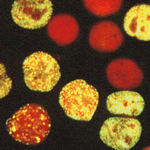Reagents
Download the anit-BrdU antibody data sheet

About us | Contact us | Ordering | Home

Phoenix Flow Systems is an one antibody company. We sell our anti-BrdU antibody (clone 3D4). It is used to measure cell proliferation. How the antibody works is explained below. We sell it in many conjugations as listed at the right but we do not sell a phycoerytherin conjugation. We grow our own clone, purify and conjugate our own antibody. If you have some special needs or bulk quantities, please contact us. We are happy to accommodate.
| Laser | Fluorochrome | Excitation/Emission | Part # |
|---|---|---|---|
| Argon | Phoenix Green | 488/520nm | ABFM-18 |
| Argon | Alexa 488 | 488/520nm | AX488 |
| Argon | Phoenix Red | 488/576nm | ABTC-20 |
| HeNe | Alexa 647 | 633/670nm | AX647 |
| Biotinylated | PRBBIOA | ||
| Unconjugated | PRB1-U |
What follows is an explanation of how the anti-BrdU antibody is used in a proliferation assay. You may ask yourself what is an anti-BrdU antibody doing in our apoptosis kit, Apo-BrdU? The anti-BrdU antibody is only used as a carrier for the fluorescent label in this assay. There are multiple patents on the dUTP-FITC molecule. Dr. Danzykiwicz discovered you could use a dUTP-Br as a labeling molecule in the TUNEL apoptosis assay more effectively than a dUTP-FITC. It worked out convenient for us, because when we licensed the Apo-BrdU technology from Dr. D. we had plenty of anti-BrdU antibody to make the kits with, so this lowered the manufacturing costs and allowed us to give more assays per kit.
One of the most easily measured features of cell proliferation is the changing amount of cellular DNA associated with each of the cell cycle phases. Cellular DNA may be labeled with any of a variety of DNA binding fluorochromes and the subsequent fluorescence measured to determine the relative DNA content and cell cycle position of the cells being studied. This type of measurement is inherently somewhat imprecise, though, with the cutoffs between the G0/G1-, S- and G2/M-phases of the cell cycle not clearly delineated. This is why we sell our DNA cell cycle analysis software, MultiCycle AV It is often desirable to have a means of unequivocally identifying actively proliferating cells and the most straightforward manner for doing this is to some how specifically label newly replicated DNA.
Though there are several approaches to accomplishing this, the methods of choice involve some how labeling the nucleotide building blocks that are incorporated during DNA replication. An ingenious method for allowing this has been developed, involving the use of 5-bromo-2-deoxyuridine (BrdU), a thymidine analog. As a thymidine analog, BrdU is preferentially incorporated into newly replicated DNA and can then be subsequently labeled, unequivocally identifying cells containing such DNA. The growth of cells in the presence of 5-bromo-2-deoxyuridine (BrdU) has become an accepted method for monitoring DNA replication.
The use of BrdU for assaying DNA replication has replaced methods utilizing radioisotope-labeled thymidine in both research and clinical laboratories. The incorporation of BrdU into cellular DNA is most commonly detected using anti-BrdU antibodies. We sell this antibody in 60 test vials. Not only do we have the usual green conjugation, but we also feature a red conjugation which can be measured in the phycoerytherin channel of a flow cytometer. Also offered are two conjugations from Invitrogen, the Alexa 647 for excitation with a HeNe laser and the Alexa 488. These are useful in image cytometry for their superior resistance to fading under a light source.

Specificity;
5-Bromo-deoxyuridine (BrdU) is a uridine derivative that can be incorporated into DNA in place of thymidine. Anti-BrdU
identifies BrdU (but not thymidine) in single-stranded DNA, free BrdU, or BrdU coupled to a protein carrier. The antibody
also reacts with iodouridine.
Clone:
Anti-BrdU, clone 3D4, is derived from the hybridization of mouse myeloma cells with spleen cells from BALB/C mice immunized with iodouridine-conjugated ovabumin
Ig Chain Composition:
Anti-BrdU is composed of mouse IgG1 heavy chains and kappa light chains.
Working Dilution:
Each vial contains enough antibody for 60 tests at a
concentration of 1µg per reaction. The suggested dilution is 1:20.